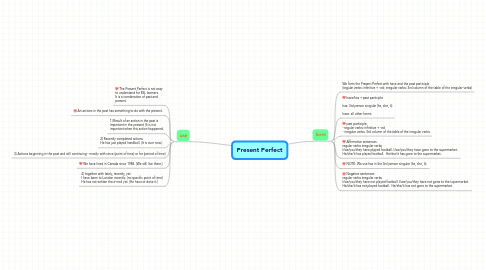Present Perfect
carlos veraにより

1. use
1.1. The Present Perfect is not easy to understand for ESL learners. It is a combination of past and present.
1.2. An actions in the past has something to do with the present.
1.3. 1) Result of an action in the past is important in the present (It is not important when this action happened.
1.4. 2) Recently completed actions He has just played handball. (It is over now.)
1.5. 3) Actions beginning in the past and still continuing - mostly with since (point of time) or for (period of time)
1.6. We have lived in Canada since 1986. (We still live there.)
1.7. 4) together with lately, recently, yet I have been to London recently. (no specific point of time) He has not written the e-mail yet. (He has not done it.)
2. form
2.1. We form the Present Perfect with have and the past participle (regular verbs: infinitive + -ed; irregular verbs: 3rd column of the table of the irregular verbs)
2.2. have/has + past participle has: 3rd person singular (he, she, it) have: all other forms
2.3. past participle: - regular verbs: infinitive + -ed - irregular verbs: 3rd column of the table of the irregular verbs
2.4. Affirmative sentences regular verbs irregular verbs I/we/you/they have played football. I/we/you/they have gone to the supermarket. He/she/it has played football. He/she/it has gone to the supermarket.
2.5. NOTE: We use has in the 3rd person singular (he, she, it).
2.6. Negative sentences regular verbs irregular verbs I/we/you/they have not played football. I/we/you/they have not gone to the supermarket. He/she/it has not played football. He/she/it has not gone to the supermarket.


